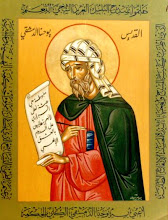The Psalms – the Kathismata
Returning to Orthros: The appointed selections from the Psalms are followed by poetic “sessional hymns”. Byzantine Christianity sees the Psalms as the archetypal offerings of praise to God, and traditionally, the entire Psalter is read each week, twice each week during Great Lent.
The Byzantine Psalter is divided into twenty sections, each called a Kathisma. The terms “Kathisma” (plural “Kathismata”) and “sessional” both indicate sitting and all may sit during this time, except when the “Glory to the Father” is intoned. The sessional hymns emphasize important themes in the psalms and relate them to our Christian life. They serve as meditations on human life and God’s merciful interaction in it. The spiritual movement that began with the Trisagion Prayers, the Six Psalms, Litany and Troparia, takes an additional step as the Grace of our Lord is revealed now in the Kathismata readings and reflected in the sessional hymns.
Each Kathisma is divided into three stases. At the end of the first two stases, the Glory … Now and ever… is intoned, followed by the triple intoning of “Alleluia, alleluia, alleluia; Glory to You, O God”, “Lord, have mercy” three times, and Glory … Now and ever…
The third stasis concludes with Glory … Now and ever…, the triple intoning of “Alleluia, alleluia, alleluia; Glory to You, O God” and “O (our God and) our Hope, glory to you.”
Originally, and still today in monastic settings, two Kathismata (three during Great Lent) are each followed by a set of sessional hymns. In practice today, most parishes omit the Psalms and merely include the sessional hymns alone, although including the Kathismata would only add about twenty minutes to the service.
The sessional hymns generally come from the Octoechos. They may be intoned or chanted in the appointed tone.
The Evlogitaria, Hypacoi, Anavathmi, Prokimenon and Gospel
Evlogitaria
On Sundays and Great Feasts, the Evlogitaria follows the Kathismata. The word “evlogitaria” comes from the Greek word for “blessed” and is so named for the refrain “Blessed are You, O Lord; teach me Your statutes,” that punctuates these hymns devoted to the Resurrection of Christ. (For Saturdays commemorating the dead and funerals there is a second series of evlogitaria; and on certain occasions the Sunday evlogitaria are omitted in favor of Psalms called the “Polyeleos”.)
As the psalms of the Kathismata become sources of inspiration when viewed in the light of the Cross, the Evlogitaria is an exclamation of joy in the mercy of the Resurrection. It completes the spiritual movement to jubilant adoration of the Holy Trinity.
A short litany leads to the Hypacoi, Anavathmi and Prokimenon.
Hypacoi and Anavathmi
Hypacoi (“hearing”) are hymns usually referencing the hearing the proclamation of the Resurrectionby the myrrh-bearing women. The Anavathmi, “hymns of ascent”, are related to the psalms; they are short hymns praising the Holy Trinity. Each tone has three Anavathmi; except tone eight, which has four. They may be chanted or simply intoned. In some churches, the Hypacoi is read, and the Anavathmi are intoned.
Prokimenon and Eothinon Gospel
The Prokimenon is a short set of psalm verses that precedes a reading from Scripture, in this case the Gospel. The Gospel reading for Orthros is usually one of eleven passages dealing with the Resurrection of Christ, which rotate one after the other on a weekly basis. These Gospel passages are called the “Eothina Gospels”, and each Eothinon (from the Greek for “dawn”) is associated with one of the eight tones. Several hymns are related to each Eothinon, and chanted in the tone associated with it, adding richness of the musical experience of the service.
The Eothinon is always read by the priest, typically from the “south” side of the Holy Table. This symbolizes dawn as the moment between light and darkness. In traditional monastic settings, Orthros begins before dawn so that the Eothinon will be read in the early morning light.
After the reading, the people come forward to reverence the Gospel Book. On certain occasions, the Gospel is related to a Feast of the Lord or the Theotokos; in these cases it is read from the Ambon and there is no reverencing of the Gospel Book.
Concluding Elements of the First Part of Orthros
The first half of Orthros draws to a close with the reverencing of the Gospel Book while a few hymns and Psalm 50 are chanted. Psalm 50, a hymn of repentance, nonetheless maintains the assurance of God’s mercy. It forms an optimistic contrast to the Six Psalms earlier, as the joy of Christ’s resurrection is revealed to be the substance of hope on which all can depend.
A dismissal-like concluding prayer is intoned by the deacon (instead of the priest, indicating that this is not the end of Orthros itself). The prayer asks God’s mercy while referencing various saints, in this way emphasizing our shared devotion with them. The prayer is customarily referred to as the “intercessional prayer”.
Subscribe to:
Post Comments (Atom)


No comments:
Post a Comment